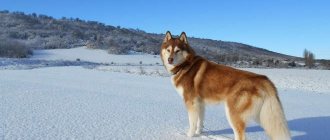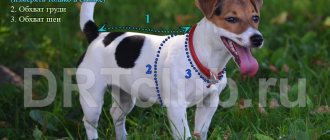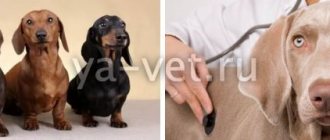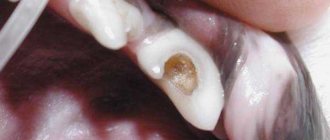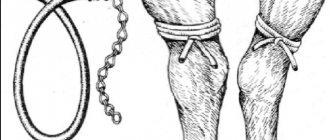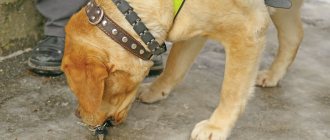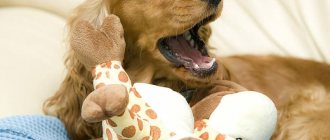Prolapse of hemorrhoids is a fairly common problem encountered in humans. It occurs due to a shift in the center of gravity to the pelvic area, which is typical for mammals that move on two limbs. Because of this, some owners doubt whether a dog can have hemorrhoids, or whether such a problem is completely alien to them.
Do dogs get hemorrhoids and what is it?
Hemorrhoids in dogs are a fairly rare phenomenon, accompanied by pathological dilation of the hemorrhoidal veins. This disorder occurs against the background of a slowing outflow of blood. Due to stagnation, the walls of the veins stretch and become thinner. Accumulating blood provokes the development of inflammation.
Dilated veins become deformed and form nodes, which eventually fall out of the anus. The swollen tissues cannot withstand the pressure and rupture, opening bleeding.
What are hemorrhoids and why does it develop?
Anyone who has ever been interested in this disease knows that it is characteristic of humans. This is due to the fact that we humans walk on two legs. It would seem that what is the connection? The answer is simple - when walking upright, the center of gravity is unevenly distributed and is mostly concentrated in the pelvic area, which has an adverse effect on the tone of the veins and vessels of the pelvis. Based on the above, the question arises - what do animals have to do with it, because their center of gravity is distributed evenly, let's figure it out!
With a decrease in venous tone and excess pressure, the vascular wall becomes thinner. Insufficient outflow of venous blood leads to the formation of hemorrhoids (they look like lumps), in which blood accumulates.
Hemorrhoids are classified according to their location:
- internal - node, located in the rectum, not visible during examination, diagnosed by internal palpation of the rectum;
- external - a node located at the anus, diagnosed with a simple examination.
Let's look at the main causes of this disease:
- improper nutrition (the dog’s diet contains mainly dry food, fats from food, a small amount of water, vitamins and microelements):
- obesity;
- lack of exercise (walks), physical activity;
- very heavy physical activity (during long-term heavy training);
- dehydration;
- hormonal imbalance;
- severe helminthic diseases.
The most susceptible to this delicate disease are older dogs, as well as pets prone to obesity - mainly indoor dogs such as pugs, Pekingese, small bulldogs, dachshunds, beagles and others.
The appearance of the disease
Hemorrhoids in dogs occur due to dilation and further inflammation of the veins located near the anus. Inflamed nodes can be located both around the anal ring and inside the rectum (internal hemorrhoids). The main reason for the appearance and development of hemorrhoids in dogs is considered to be congestion, as a result of which the hemorrhoidal veins are not completely freed. After this, the density of the venous walls decreases, which leads to the appearance of compactions (bumps).
An ideal example would be a regular rubber hose. If you start pumping water into one end and securely plug the other end, then a huge bubble will appear in the place that has the thinnest walls. The same thing happens with veins, which accumulate blood. They gradually stretch, making the walls thinner, which after exercise leads to the appearance of blood bumps.
Signs of illness
When hemorrhoids appear in a dog, the symptoms are the same as, for example, in a cat. Experts recommend paying attention to the fact that during illness:
- Feces become denser and dryer.
- The anus enlarges and swells.
- There are clots of blood and mucus in the stool.
- The dog's gait changes.
Perhaps the dog will begin to rub his butt on the floor, grass, carpet, trying to get rid of discomfort and itching. However, most often this behavior is observed in animals that have worms.
As soon as you notice the characteristic signs of hemorrhoids in a dog, you need to contact a veterinarian who will conduct a full diagnosis of your pet. Only an experienced specialist will give the most comprehensive answer to what is happening in the animal’s body, and will also prescribe the correct treatment. Very often, people confuse hemorrhoids with a hernia, inflammation of the anal glands, or rectal prolapse.
Course of the disease
Hemorrhoidal veins are present in all mammals. As a rule, when exposed to various factors, pathological changes may occur in these veins. The pathology begins to develop imperceptibly from a sluggish internal inflammatory process. Blood thickening or deterioration of blood flow can accelerate the development of pathology.
If left untreated, hemorrhoids lead to bleeding and bowel prolapse.
As a result, the hemorrhoidal vein fills with blood. The further process can be compared to the situation when a segment in a rubber tube becomes thinner and, with increasing pressure on it, a bubble forms. It’s the same in a vein: stagnation of blood begins to gradually stretch its walls, causing it to become thinner. The blood does not find a way out and begins to provoke inflammation.
At some point, the connective tissue that forms the walls of the vein and is provoked by any external or internal factors cannot withstand it and is inflated into nodes, and then swelling develops. The blood inflates the knot more and more, which sooner or later falls out. In the absence of treatment, including anti-inflammatory treatment, the vein wall sooner or later ceases to contain pressure, and bleeding occurs.
Reasons for the development of the disease
Hemorrhoids in dogs occur due to congestion in the lower part of the pelvis, reducing the tone of the blood vessels. Such violations are associated with the presence of the following factors:
- lack or excess of physical activity;
- advanced helminthiasis;
- frequent pregnancies that increase pelvic pressure;
- malignant neoplasms in the intestines;
- regular constipation and intestinal obstruction;
- obesity, which causes vein blockage;
- lack of vitamins and minerals associated with the use of cheap feed or an incorrectly selected diet (lack of balance of KBJU);
- pathologies of the genitourinary system (ulcerative urolithiasis, cystitis);
- dehydration.
The risk group includes older pets and decorative breeds (Yorkies, Pekingese, Toy Poodles) that rarely go outside. Pathology in puppies is less common - in their case, the lack of vitamins necessary for the formation of bones and muscles is to blame.
Why do hemorrhoids appear in dogs?
By analogy with people, hemorrhoids in domestic dogs are provoked by disturbances in the regulation of the inflow and outflow of blood in the veins of the rectum with further stagnation in the pelvis. There may be several reasons for this phenomenon, but they are all directly related to violations in caring for the pet.
The most typical causes of the disorder include the following:
- improper, “rough” nutrition, which results in frequent constipation (for example, using dry low-quality food in the absence of water only harms the dog);
- complete lack of movement or excessive physical activity;
- increased cholesterol levels and the formation of cholesterol plaques on the walls of the veins, resulting in blockage of the veins;
- severe infestation of the dog with worms;
- lack of vitamins and microelements in the diet;
- frequent pregnancies in bitches, especially at older ages (pressure in the pelvis impairs blood circulation);
- chronic diseases of the genitourinary organs (for example, urolithiasis or cystitis);
- malignant neoplasms;
- lack of vitamins and minerals in childhood, when up to 7 months puppies are limited in obtaining the building material they need to form muscle and bone tissue.
Did you know? The bite force of large dog breeds often reaches a pressure of 150 kg, while a person can bite with a force of 50 kg. This statement applies to Rottweilers, German Shepherds and American Pit Bull Terriers, on which this indicator was measured.
Throughout life, negative factors affecting the health of the animal only accumulate, which leads to the development of various ailments. For this reason, hemorrhoids are common among older dogs, especially those with excess weight problems.
Symptoms that should alert you
Symptoms and treatment of hemorrhoids in dogs depend on its type, course and stage of development. At the very beginning, severe itching occurs, so the pet anxiously licks or rubs its anus on surrounding objects. Over time, the signs become more alarming:
- dry and hard feces mixed with mucus and blood clots;
- redness and swelling of the anus;
- pain during bowel movements, accompanied by whining or squealing;
- unusually wide stance of the paws while walking.
In more severe cases, prolapse of hemorrhoids is noted, which can be seen in detail in the photo. After damage to the venous walls, the symptoms are supplemented by severe bleeding and paleness of the mucous membranes due to anemia.
Diagnostics in a veterinary clinic
Identifying hemorrhoids and differentiating them from other health problems is quite difficult for a non-professional, so if you suspect the disease, you must take the animal to the clinic.
The veterinarian will be able to conduct an examination and find out whether the dog really has hemorrhoids, or whether it is inflammation of the paraanal glands, a fissure or prolapse of the rectum, a tumor or hernia. For an accurate diagnosis, it will be necessary to carry out not only instrumental and instrumental examinations, but also a set of tests.
Stages of disease development
The disease develops progressively and goes through 4 stages of development. They all have their own characteristic symptoms:
- In the first stage, only itching appears. The owner can detect a violation by too frequent licking and riding on the butt. Redness and inflammation of the mucous membrane will only be noticeable to a veterinarian.
- In the second stage, acute pain is added to the itching. Fecal masses moving through the intestine touch the inflamed veins, complicating emptying.
- At the third stage, scarlet blood appears in the feces, and some nodes fall out.
- In the fourth stage, small amounts of blood are replaced by heavy bleeding from the anus. Without timely help, the pet risks dying from anemia.
If you notice at least one of the alarming symptoms, be sure to seek help. Many of the symptoms are similar to other pathologies, so before starting treatment you need to make sure of the exact cause of the ailment.
Dietary recommendations
The animal's feces should have an optimal consistency - not too runny and not too dry. Therefore, the dog needs to be fed properly.
Your dog's stool should be of normal consistency.
Natural food
If the owner feeds his pet only “natural” food, then fiber should be present in his diet. It is recommended to give the animal steamed vegetables, as well as porridge.
It is recommended to include steamed vegetables in your dog's diet.
The most useful cereals are:
- Buckwheat.
- Rice.
- Oatmeal.
Buckwheat
Buckwheat is rich in calcium, iron, magnesium and potassium. Its use has a beneficial effect on the nervous and circulatory systems.
Buckwheat has a beneficial effect on the circulatory system.
Rice
Rice contains vitamin B.
Rice is healthy due to its vitamin B content.
To avoid constipation, it is recommended to mix rice with buckwheat.
Oatmeal
Oatmeal contains amino acids. But you shouldn’t give it to your dog often, as it causes allergies and contributes to bowel problems.
It is not recommended to feed your dog oatmeal frequently.
What is not allowed!!!
You should not give your dog semolina, millet or corn porridge. It is necessary to exclude bones and other difficult-to-digest products from your pet’s diet. It is not advisable to give your dog sweets, including cookies. It is strictly forbidden to feed the animal from the table.
You should not give sweets to your dog.
Special food
It is advisable to change your usual dry food to products from another manufacturer. The animal needs to be fed high quality food.
Dog food must be of high quality.
The food must meet all the needs of the breed. You cannot feed puppies with products for adult dogs, and vice versa. It is advisable to avoid canned food .
Diagnostic procedures
Diagnosis of hemorrhoids in dogs includes external examination of the anus and its palpation. If all nodes are out of sight, then the rectum is examined from the inside. To determine concomitant diseases, you will need to undergo a series of tests.
What tests will the doctor take?
The rate of blood clotting is determined using a coagulogram - a comprehensive study of a venous blood sample. To exclude parasitic infestation, a stool test is performed, and an intestinal biopsy is performed to exclude neoplasms.
What can be confused with hemorrhoids in dogs?
The problem with hemorrhoidal veins in four-legged pets is a real rarity. For this reason, it is important to make sure that the symptoms that arise do not indicate similar diseases:
- helminthiases;
- anal fissures;
- hernia or prolapse of the rectum;
- inflammation of the paraanal glands;
- paraproctitis;
- neoplasms in the rectum;
- ulcerative colitis.
Do not rush to draw conclusions before completing all the necessary research. In most cases, the cause of the malaise lies in one of the listed pathologies.
Symptoms
In dogs, hemorrhoids exhibit their own characteristic symptoms. An attentive owner who notes any changes in the pet’s condition will easily notice signs of incipient hemorrhoids.
Timely contact with a veterinarian makes it possible to prevent the development of serious complications associated with dilated veins in the lower part of the rectum, and will also save the animal from suffering. Typical signs of hemorrhoids in dogs are:
- change of gait – the pet quite clearly changes its gait and positions its pelvic limbs. This allows you to minimize the risk of injury to the area with an inflammatory process in the anus;
- swelling and severe redness at the location of the anal outlet;
- the appearance of specific red blood streaks in the feces;
- the appearance of characteristic hemorrhoids and lumps at the exit site of the rectum;
- problems with going to the toilet - disruption of bowel movements, characterized by constipation, specific spasms, severe dryness of feces and a change in their consistency to hard;
- the appearance of lethargy and apathy in the dog;
- problems with eating (refusal of food and treats), increased thirst;
- a sharp increase in the portion of urine excreted, associated with polydipsia.
Dogs have hemorrhoids in mild and advanced forms. At the very beginning of the pathological process, there are practically no symptoms. With the development of hemorrhoids, it is painful for the dog to go to the toilet, it strains and whines. It is clear that the animal is suffering.
Procedures and treatments
After diagnosis, the veterinarian will definitely tell you how to treat hemorrhoids in a dog, based on its stage. Available treatment methods include taking medications and folk remedies, administering enemas and taking healing baths. Surgery is used only in extreme cases, when other methods do not give the desired effect.
Drug therapy and folk remedies
In the first two stages, treatment of hemorrhoids in dogs is carried out at home. To improve the patient’s well-being, use:
- venotonics (Venarus, Detralex), which promote healthy blood vessels and prevent stagnation of venous blood;
- antiseptic ointments and sea buckthorn oil necessary for treating an inflamed anus;
- laxatives (Guttalax, Duphalac, castor oil), facilitating bowel movements;
- hemostatic suppositories (hemostatic suppositories).
If the disease is advanced, hospitalization may be required. Acute pain is relieved with anesthetics, and vasoconstrictor and hemostatic drugs are used to stop bleeding. Due to the high probability of a secondary infection, the four-legged patient is prescribed antibiotics.
The use of traditional medicine is permissible as an auxiliary therapy in consultation with the attending physician. Drinking plenty of yarrow infusions and special herbal baths help well.
Administration of an enema
You can make defecation easier not only by taking laxatives orally, but also by giving an enema. The effect of this procedure appears within 15 minutes. If the pet has been patient for a long time, then it can go to the toilet immediately after the procedure.
Most of the laxative solution should be water, and the rest should be Vaseline, chamomile decoction, fish oil, glycerin or soap solution. The amount of liquid depends on the weight of the pet:
- 50 ml – small breed dogs up to 10 kg;
- 200 ml – medium-sized breeds from 11 to 25 kg;
- 500 ml – large breeds from 26 to 44 kg;
- 1000 ml – giant breeds weighing more than 44 kg.
Puppies are allowed no more than 1 tablespoon of water without additional impurities. Due to the large number of contraindications, including anal bleeding, the procedure is carried out only in consultation with a veterinarian.
If the injected liquid flows out of the anus and does not pass inside, you must urgently stop the procedure and seek help from a veterinary clinic. The problem that has arisen indicates intestinal obstruction, so further actions may result in intestinal rupture.
Special baths
After walking, it is recommended to wash the inflamed anus with a cool decoction of yarrow, St. John's wort, calendula, burdock root and sage. Such herbal baths have the following benefits:
- eliminate swelling;
- reduce nodules;
- relieve pain;
- reduce the amount of bleeding.
The temperature of the solution should differ from the pet’s body temperature by 3-4 degrees. For the effectiveness of the procedure, it is recommended to measure the indicator with a thermometer.
Surgical intervention
Surgery is resorted to in the absence of a positive effect from taking medications and in advanced forms of the disease. Surgical intervention is indicated for animals with the following symptoms:
- heavy bleeding;
- large nodes;
- extensive swelling.
The operation is performed under general anesthesia. The surgeon excises part of the rectal tissue located above the damaged area. The existing nodules are tied with a thread at the base, promoting their independent death due to lack of blood. A faster method is cryodestruction, that is, exposure to liquid nitrogen.
Diagnosis and treatment of the disease
Treatment of hemorrhoids in a dog begins with an accurate diagnosis. The exact cause of the disease can only be determined in a hospital setting by an experienced veterinarian.
An indicative study for identifying true hemorrhoids is a coagulogram. The test is necessary to determine the rate at which a dog's blood clots. In addition, the study makes it possible to evaluate the status of the blood clotting factor.
A hormonal panel is also carried out to determine the amount of hormones and sugar in the bloodstream.
Analysis of feces is important to determine the presence of helminthiases that complicate the course of the underlying disease. A general clinical examination and palpation examination of the paraanal glands are necessary. It is not possible to diagnose yourself at home.
Treatment of the pathological process depends on how advanced the processes in the anal area are against the background of developed hemorrhoids. At the very first stages of the disease, it is recommended to provide the dog with proper nutrition, including a large amount of fiber, plant origin and fermented milk products. It is necessary to provide the dog with free access to clean drinking water. Treatment consists of several main points:
- prescribing suppositories for hemorrhoids, which promote rapid healing of the affected areas and relieve inflammation;
- symptomatic drugs prescribed by a veterinarian depending on what became the main factor that triggered the development of hemorrhoids;
- the use of special means - vetotonics, which have the ability to increase blood flow in the pelvis.
The disease must be treated comprehensively.
Decoctions of medicinal herbs that have anti-inflammatory and antiseptic effects are also prescribed. Infusions of chamomile and plantain have a pronounced anti-inflammatory effect and also have an antithrombotic effect.
Liniments and ointments are prescribed as an aid to eliminate itching and discomfort. They are also necessary to prevent infection of microcracks formed in the anal area.
Advanced cases of hemorrhoids in dogs can only be treated surgically. Surgical intervention is prescribed, the purpose of which is to eliminate hemorrhoids. Used to freeze hemorrhoid cones - liquid nitrogen and surgical excision of the affected area.
Diet is an important condition for recovery
No less important is a therapeutic diet, which involves a revision of the diet. With its help, it is necessary to stabilize the consistency of feces and reduce the load on the inflamed intestines.
What products can be consumed and in what form?
To recover, your pet will need a lot of fiber and easily digestible foods. The basis of the diet should be lean meat (veal, chicken) and offal. Vegetables should be boiled or steamed.
Porridge can and should be cooked in light meat broth. Suitable cereals include rice, buckwheat and oatmeal. They are enriched with all necessary vitamins and have a beneficial effect on the circulatory system.
From fermented milk products, it is recommended to give fresh sour cream, cottage cheese and kefir. Choose brands with low fat content and a short shelf life, eliminating the addition of preservatives.
To improve digestion, it is recommended to add bran or probiotics to prepared meals. The food itself should be served in small pieces, as otherwise it may damage the mucous membranes.
Forbidden food
It is necessary to exclude any food from the human table from the diet: sweets, baked goods, smoked foods, pickles, spices, canned food and fried foods. As for cereals, you should avoid millet, semolina and corn porridge.
Until recovery, your pet should not be given any bones (even the shoulder blade and sternum), since these products are difficult to digest.
Industrial feed
If a dog is diagnosed with hemorrhoids, then dry food from a veterinary line intended for the treatment of gastrointestinal pathologies is suitable for it. The brands Eukanuba, Hill's and Royal Canin have such diets. To ensure comfortable digestion of dry kibble, your pet should always have access to fresh water.
Establishing a diagnosis
First of all, the veterinarian undertakes to differentiate among all pathologies that have similar symptoms.
In addition to inflammation of the paraanal glands, this pathology can be easily confused with hernia and rectal prolapse.
The dog has inflammation of the paraanal glands.
Therefore, the veterinarian not only carefully examines the four-legged patient, but also sends him for tests.
